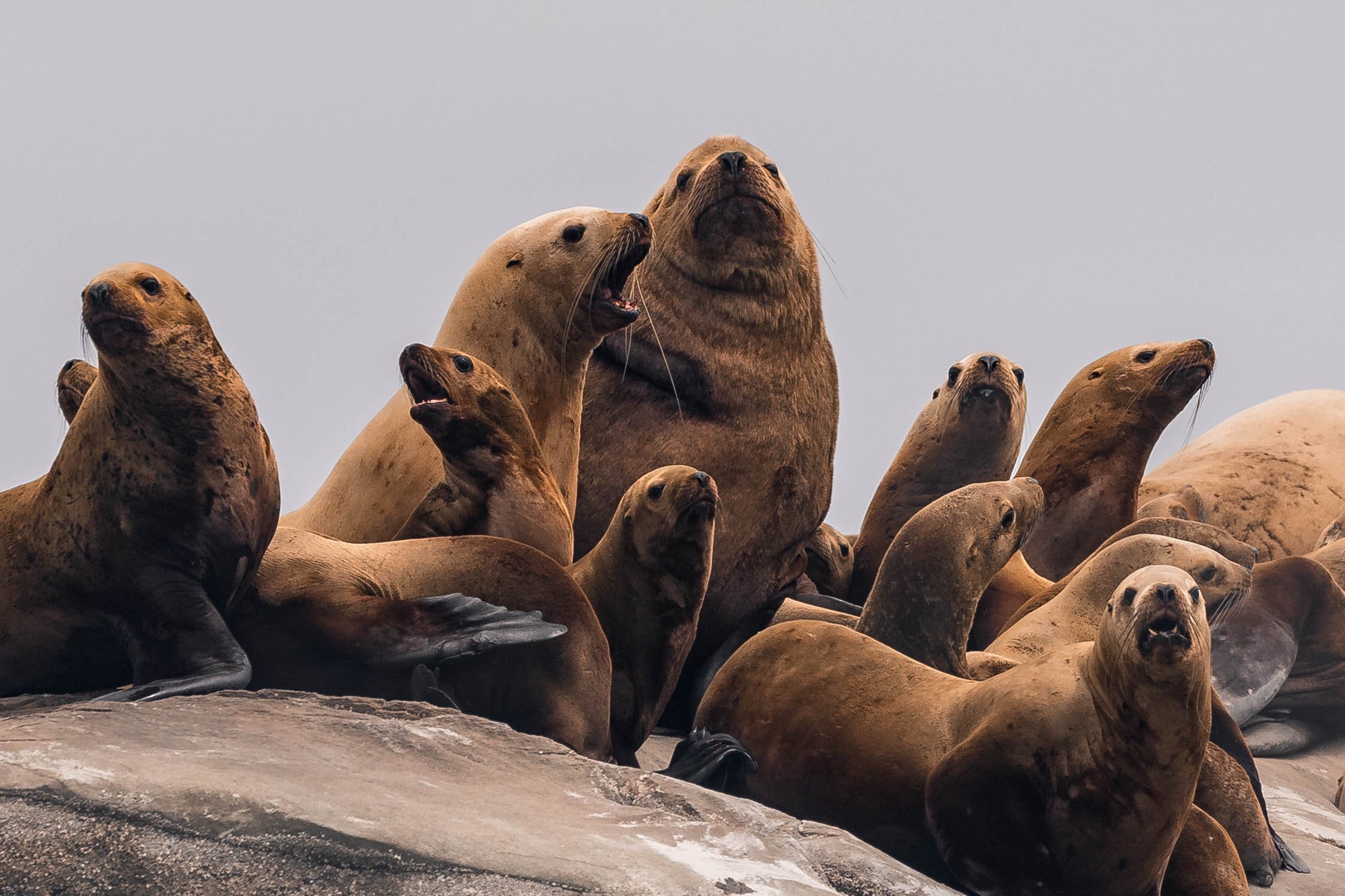May 31, 2025 - Lots of Humpback Action!
On the final day of the month, vessels Kula and Cascadia eagerly set out from Nanaimo, undeterred by gloomy skies and gusty waves. Spirits were high while we scanned the horizon for tail flukes and blow spouts. Luckily, our vessels didn’t have far to go!
Just north of Snake island, the action began.
A lone humpback had been spotted, and it was none other than Dalmatian (BCY0994)! This giant must have been full of energy since he was very active, treating us to fin and tail slaps, and even with full breaching.
Like other humpbacks, Dalmatian has just returned to our coastal waters from subtropical breeding grounds. While Dalmatian has just returned from Mexico, other humpbacks that visit British Columbia to feed may migrate from Hawaii or South America. These incredible animals undertake one of the longest migrations of any mammal in the world.
Humpbacks were once the most hunted whale species during the era of commercial whaling along the Pacific coast. Their relatively slow swimming speed and their migration path along the coastline made them easy prey to commercial whalers. By the time commercial whaling had been phased out by the 1960s and 70s, the damage had already been done. It’s estimated that the northern-pacific humpback population had declined by 90%.
Since the end of commercial whaling, humpback whale populations have slowly been making a comeback. One remarkable example of this recovery is the story of Heather (BCY0160), the mother of Dalmatian.
In just 18 years, Heather has had five calves of her own (including Dalmatian). Her eldest child, Split Fluke (BCX1068), has gone on to have three calves herself. This means that Heather has, directly and indirectly, contributed eight new humpbacks to our coastal waters in a combined 19 years. This story is a great example of how one breeding female can have a lasting impact on the recovery of an entire community.
In addition to humpback action, two pinniped species made a memorable appearance: the harbour seal and the Steller sea lion.
Harbour seals, often seen lounging on rocky shorelines, are quite small compared to their sea lion cousins. They can grow up to 6 feet in length and weigh around 280 lbs. As “true seals,” they belong to a different evolutionary lineage than sea lions. One of the key differences lies in their anatomy: true seals lack external ear flaps (pinnae) and have smaller front flippers. Their pelvic bones are fused, which limits their ability to move on land, but it gives them a powerful advantage in the water. This adaptation enhances thrust and agility, crucial when evading their primary predator: the killer whale. When not napping on rocks during the day, these nocturnal hunters rely on sensitive whiskers to hunt. Their whiskers are packed with nerve endings to detect vibrations from prey like small schooling fish, squid, and octopus.
In addition to harbour seals, Steller sea lions were spotted in great abundance! Males can reach up to 11 feet in length and weigh as much as 2,500 lbs, making them the largest sea lion species in the world. Unlike seals, they have large, visible ear flaps, robust front flippers, and unfused pelvic bones that allow them to “walk” on land by rotating their hind flippers underneath them.
Steller sea lions exhibit a trait called sexual dimorphism, where males grow 2–3 times larger than females, a crucial advantage during the breeding season, which has just begun and runs through mid-July. During this time, dominant males claim and defend harems of females on rocky haul-outs. Incredibly, these males will fast and remain on land, without entering the water to feed, for the entire two-month period!
While seals and sea lions competed for our attention, the skies and cliffs were busy too. We spotted a variety of bird species, including bald eagles, turkey vultures, cormorants, and black oystercatchers.
With energetic whale encounters offshore, lazy seals sunbathing, territorial sea lions bellowing, and a flurry of avian activity above, this trip offered an amazing mix of wildlife action. All of its beauty was narrated and documented by our talented onboard marine naturalists and photographers, Val Watson and Hayleigh Hilbert. See their photos below!
The underside of Dalmatian’s tail. Photo by Val Watson.
Dalmatian going for a large tail slap! Photo by Val Watson.
Dalmatian’s tail held high. Photo by Val Watson.
Dalmatian giving us a peak at his pectoral fin. Photo by Val Watson.
Dalmatian waving hello with his pectoral fin. Photo by Hayleigh Hilbert.
Dalmatian’s tail fluke. Photo by Hayleigh Hilbert.
A good identification shot of Dalmatian’s tail fluke. Markings and colorations on the tail fluke of humpbacks are used for photo identification all around the world. Photo by Hayleigh Hilbert.
Dalmatian making a splash with his tail! Photo by Hayleigh Hilbert.
Dalmatian showing off! Photo by Val Watson.
A look at Dalmatian’s dorsal-side. Photo by Val Watson.
Dalmatian going for a back-splash! Photo by Val Watson.
A good look at Dalmatian‘s long pectoral fin. A humpback’s pectoral fin can grow up to 1/3 the length of their body! Photo by Hayleigh Hilbert.
Dalmatian breaching again. Photo by Hayleigh Hilbert.
Harbour seals! One is giving us the iconic banana pose. Photo by Hayleigh Hilbert.
An itchy harbour seal with friends. Photo by Hayleigh Hilbert.
Harbour seal! Photo by Hayleigh Hilbert.
A large male Steller sea lion! Photo by Val Watson.
Steller sea lions keeping watch. Photo by Hayleigh Hilbert.
A good look at how large male Steller sea lions can get. Photo by Hayleigh Hilbert.
Steller sea lions going for a swim. Photo by Hayleigh Hilbert.
Black Oystercatchers flying! Photo by Val Watson.
A bald eagle soaring overhead. Photo by Hayleigh Hilbert.
A turkey vulture looking for food. Photo by Hayleigh Hilbert.
Pelagic cormorants on the sandstone cliffs of Gabriola Island. Photo by Val Watson.
Nesting pelagic cormorants. Photo by Val Watson.
A group of pelagic cormorants, Photo by Hayleigh Hilbert.
Passengers and crew aboard Cascadia. Photo by Val Watson.



























